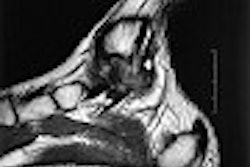Obstetric ultrasound still generates the most litigation of all sonographic studies, according to a historical survey in the Journal of Ultrasound in Medicine.
Obstetric ultrasound still generates the most litigation of all sonographic studies, according to a historical survey in the Journal of Ultrasound in Medicine.
"Litigation related to diagnostic ultrasound has become progressively more frequent as images have become easier to interpret, expectations of the ability of diagnostic ultrasound to facilitate diagnoses of subtle fetal anomalies have become higher, and equipment has become more widespread," wrote Dr. Roger Sanders of Los Alamos Women’s Health Center in Los Alamos, NM. "Obstetric ultrasound has always attracted more litigation than other aspects of diagnostic ultrasound" (JUM, October 2003, Vol. 22:10, pp. 1009-1015).
Sanders has been tracking ultrasound-related litigation with a variety of methods for more than 19 years, and has published several previous articles on this topic. In determining the 2002 series of data, Sanders included cases that he has seen as an expert witness since 1997.
The cases were biased towards obstetrical and gynecological ultrasound, as Sanders has not performed abdominal ultrasound studies since 1998. The cases were equally split between plaintiffs and defendants. And Sanders included 11 cases that he had reviewed for plaintiffs' lawyers but refused because he thought the cases had no merit.
In his 2002 findings, Sanders noted 62 cases from obstetrics, 9 from gynecology, four from abdominal, and one miscellaneous case. He did not find any litigation relating to neonatal intracranial, breast, or eye ultrasound, and did not attempt to track suits related to cardiology or fetal echocardiography. It’s also likely that many of the suits related to vascular studies or breast sonography were not included in the series, he said.
Lawsuits related to obstetric ultrasound continues to be more common than other ultrasound applications, Sanders said.
"Presumably this relates to a greater use and reliance on ultrasound in obstetrics in this country, more litigation because the financial reward from a damaged infant is large, and greater public awareness of the role of ultrasound in obstetrics," he wrote.
Missed diagnoses
Cases in which an entity was completely overlooked continue to be the most common type of suit, with 43 such cases. Missed fetal anomalies made up the lion’s share of the cases, with 27.
"Fetal anomalies, now by far the most common causes of this types of litigation, were relatively uncommon in 1983 because the images were relatively crude," he said.
Invented lesions, cases that appeared to show lesions though none were found after surgery or other interventions, generated only three cases. This subcategory was more active in 1983, mostly attributable to the use of primitive equipment, Sanders said.
Misinterpreted studies were another important subgroup, producing nine cases in the 2002 data series, Sanders said. The most common example arises from obstetric sonography performed in the third trimester.
"For example, an obstetric ultrasound study was interpreted as showing measurement data indicative of a 36-to-39-week pregnancy with no caveat about the inaccuracy of dating in the third trimester," he wrote. "At delivery, the neonate may have had hyaline membrane disease or intracranial hemorrhage. Obstetricians blamed the imager for giving a firm date that was inaccurate."
Since 1996, Sanders has seen a steady increase in misreported fetal anomalies, with spina bifida, hydrocephalus, and posterior urethral valves being the most commonly recognized in retrospect.
Failure to perform ultrasound, such as cases where the standard of practice required an ultrasound study that was not performed, was cited in three cases. Cases involving sonographers were rare, generating only 24 cases in the entire study period and occurring mostly between 1986 and 1996. Fourteen of the 24 involved alleged sexual assault.
Despite the increased use of ultrasound to guide invasive procedures, litigation in this area seems unusual, except for amniocentesis, Sanders said. In all, three cases were related to invasive procedures.
"Since (1986), suits about ultrasound and amniocentesis usually relate to whether guidance was continuous throughout the procedure or used only to select the needle site, and whether the guidance was performed appropriately," he said.
Miscellaneous cases included those related to careless wording of sonographic reports, such as neglecting to place the word "no" before "intrauterine device" and effectively changing the report to say that an IUD was present.
A new target
Litigation arising from diagnostic ultrasound has become progressively more frequent as the images have become easier to interpret, he said. Expectations of the modality’s ability to detect subtle fetal anomalies have also risen.
The targets of litigation have evolved over time as well. Ectopic pregnancy was the most common reason in the 1980s, but today, missed fetal anomaly is the most frequent indication. And invented lesions, which were often seen in past years, almost never occur today, Sanders stated.
With greater adherence to guidelines, failure to perform sonography for a recognized indication has also become a cause of litigation.
"Well-recognized obstetric ultrasound guidelines, in one respect, provide protection for those who perform faultless series and yet find no abnormalities when they are present and, in another respect, cause problems for those who do not document all the images required by the guidelines when abnormalities are subsequently found," he wrote.
By Erik L. RidleyAuntMinnie.com staff writer
November 12, 2003
Related Reading
Breast ultrasound experts share pearls and pitfalls, October 2, 2003
Policy clarifies imaging risks for pregnant women, May 15, 2002
Consideration mitigates liability in mammography, February 28, 2002
Copyright © 2003 AuntMinnie.com




















